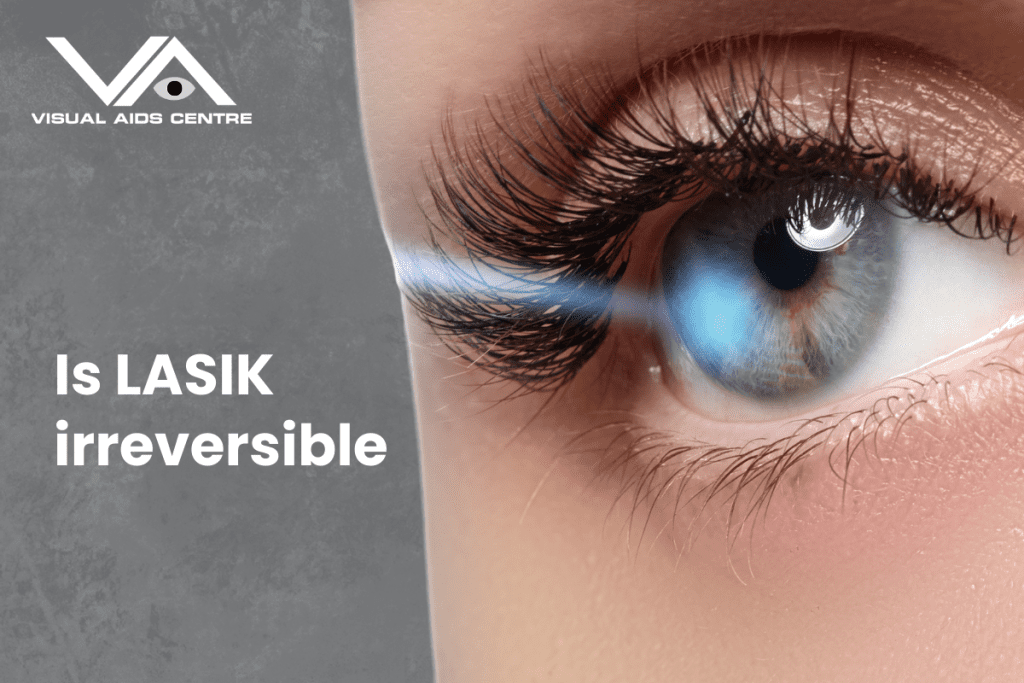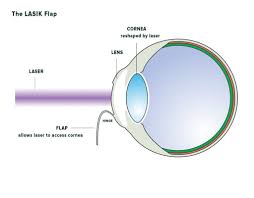Table of Contents
ToggleYes, LASIK is considered an irreversible procedure. Once the cornea is reshaped during LASIK surgery, it cannot be restored to its original form.
This is because the laser used during the process removes microscopic layers of corneal tissue permanently.
However, understanding why LASIK is irreversible and what this means for those considering the surgery requires a deeper exploration. Below, we’ll break down the science behind LASIK, the implications of its permanence, and the factors to consider when determining if LASIK is a suitable option for you.

What Happens During LASIK?
To appreciate the irreversibility of LASIK, it’s essential to understand how the procedure works. LASIK, or Laser-Assisted in Situ Keratomileusis, is a type of refractive eye surgery designed to correct vision problems like nearsightedness, farsightedness, and astigmatism. Here are the steps involved:
1. Creating a Corneal Flap
The surgeon creates a thin, hinged flap on the surface of the cornea, usually with a femtosecond laser. This allows access to the underlying corneal tissue.
2. Reshaping the Cornea
A computer-controlled excimer laser then removes precise amounts of corneal tissue. The aim is to reshape the cornea so that light entering the eye focuses correctly onto the retina, improving vision.
3. Reposition the Flap
The corneal flap is carefully repositioned back into place, acting as a natural bandage while the eye heals.
The reshaping process is what makes LASIK permanent. The laser removes microscopic layers of corneal tissue, and once this tissue is taken away, it cannot regenerate or grow back. Therefore, the changes made to the cornea are irreversible.
Why Is LASIK Irreversible?
The irreversibility of LASIK lies in the biology of the cornea and the mechanism of the excimer laser.
- Corneal Tissue (Stroma) Cannot Regenerate
Unlike some parts of your body that can heal and regenerate tissue (like skin), the corneal stroma cannot regrow once the tissue has been removed by the laser. The structural alterations are permanent.
- Precise Tissue Removal
The excimer laser works with extreme accuracy, removing only microns of tissue at a time. While this precision minimises risks, it also ensures the corneal changes are fixed and final.
- Permanent Reshaping
The reshaped cornea alters the way light refracts into the eye to correct vision problems. This new shape is designed to last a lifetime, which makes the procedure irreversible.
Does Irreversibility Mean No Flexibility?
While the procedure itself is irreversible, this doesn’t mean you’re left without options should vision changes or complications arise down the line. It’s important to note that:
- Some post-LASIK patients can undergo enhancement procedures to fine-tune results. However, these are considered secondary procedures and depend on factors like corneal thickness.
- Technologies such as PRK (Photorefractive Keratectomy) may be explored as an alternative adjustment in specific cases.
Can Vision Deteriorate After LASIK?
Although the changes made to your cornea during LASIK are permanent, other factors can influence your vision over time. Common reasons for further vision issues post-LASIK include:
1. Ageing-Related Vision Changes
Conditions like presbyopia (age-related farsightedness) typically develop around the age of 40 and are unrelated to LASIK. This occurs because the natural lens inside your eye loses its flexibility, not because of changes to the cornea.
2. Natural Eye Changes
The shape and structure of your eye may naturally change over the years, affecting your vision and possibly requiring glasses or additional procedures.
3. Eye Conditions
Progressive conditions like cataracts or glaucoma can impact vision regardless of previous LASIK surgery.
It’s crucial to understand that LASIK doesn’t prevent all future eye conditions, though it significantly reduces dependency on corrective eyewear for refractive issues.
Is LASIK Safe Despite Being Irreversible?
Absolutely! LASIK’s permanence doesn’t detract from its safety or success. LASIK has one of the highest satisfaction ratings of any elective procedure. According to studies, more than 95% of LASIK patients achieve 20/40 vision or better, and most experience life-changing improvements in their quality of sight.
That said, safety and effectiveness heavily depend on your eligibility for the procedure. This is why reputable eye surgeons conduct thorough pre-surgery evaluations to ensure that LASIK is a suitable and low-risk option for you.
Factors to Consider Before Opting for LASIK
Since LASIK is irreversible, it’s vital to weigh the pros and cons carefully. Here are some critical factors to keep in mind:
1. Your Eye Health
You must have healthy corneas and stable vision to qualify for LASIK. Conditions like keratoconus or severe dry eye syndrome may disqualify you from the procedure.
2. Corneal Thickness
LASIK involves removing layers of your cornea. Therefore, you need sufficient corneal thickness for the surgery to be both effective and safe.
3. Existing Vision Prescription
LASIK is most effective for mild to moderate refractive errors. Very high prescriptions may require alternative procedures such as implantable lenses (ICLs).
4. Your Age
LASIK is generally recommended for individuals over the age of 18, as your vision should be stable. If your prescription is still changing, LASIK might not be ideal.
5. Future Vision Goals
Since LASIK permanently reshapes your cornea, understanding what you want from your vision long-term is essential. Discuss your goals with a trusted eye surgeon.
What Happens if LASIK Results Don’t Match Expectations?
While LASIK has a high success rate, no procedure is without risks. Rarely, a patient might not achieve their desired vision improvement. Common concerns include:
- Residual Refractive Error
Some patients may still need glasses or contact lenses for specific activities, such as reading small text or driving at night.
- Glare or Halos
Nighttime visual disturbances, such as glare or halos around lights, may occur but generally improve over time for most patients.
- Dry Eye
Temporary or chronic dry eye is a possible side effect but can usually be managed with treatment.
While LASIK enhancements can sometimes address these issues, they are only viable if the cornea has sufficient remaining thickness.
Key Takeaways
- LASIK is a permanent and irreversible procedure, as the corneal tissue removed during surgery cannot regenerate.
- It is a highly effective and safe way to correct refractive errors, with long-lasting results that can significantly reduce reliance on glasses or contact lenses.
- While the procedure is irreversible, enhancements may sometimes be an option for adjusting vision changes post-surgery.
- Careful screening and consultations with your surgeon are critical before deciding on LASIK since your cornea’s unique conditions affect eligibility.
Final Thoughts
The permanence of LASIK is a big part of what makes it so successful. However, potential candidates should approach the procedure with full awareness and factual information to make an informed decision.
If you’re thinking about LASIK or exploring your vision correction options, consult a licensed ophthalmologist to ensure it’s the right fit for your eyes and lifestyle. Taking this step not only sets realistic expectations but also ensures safe, dependable results.
Ultimately, understanding that LASIK is irreversible doesn’t mean apprehension—it means appreciating the capabilities of modern medical advancements to improve life through clearer vision.













